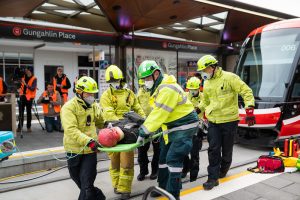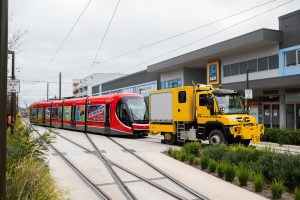As part of this year’s Rail Safety Week (RSW) initiative, CMET coordinated a real-life simulated collision scenario where representatives from ACT Policing and Emergency Services enacted the sequence of events after a pedestrian was struck and trapped by a light rail vehicle (LRV). The incident was run as a training exercise and even included students from Gungahlin College acting as injured passengers travelling on board.
CMET General Manager Tilo Franz said, “training exercises are crucial in rail operations to ensure that all agencies are prepared for worst case scenarios.”
What happened in today’s simulated light rail incident?
All the teams involved were briefed, and the incident officially began.
- The driver radioed in to the CMET Operations Control Centre (OCC), advising of the incident
- The OCC contacted emergency services
- Emergency Services responded. First on-site were ACT Fire and Rescue (ACTF&R) who assessed the situation and triaged any on-board injuries and attended to the trapped person under the LRV.
- ACT Ambulance Service (ACTAS) arrived at the scene and stabilised the patient
- ACTF&R worked to lift the LRV to free the trapped person
- ACTAS transport the now-freed injured person
- At this point the scene would be handed over to ACT Police who begin an investigation into the cause of the incident. Once ACT Police complete the investigation they hand the site over to CMET to recover the LRV.
- The LRV is assessed, and is attached to a vehicle called a Unimog to be towed away from the scene.
Is this how an incident response would occur in real life?
Today’s emergency exercise was as close to a real-life response as it could be, without impacting our passenger services. Throughout the exercise regular services continued to operate, where a real life collision would cause an impact to service.
Why run an emergency exercise?
Emergency exercises are run by operations and emergency services periodically to test the coordinated multi-departmental response required for incidents on the light rail. Just like fire drills are run to ensure everyone knows what to do to safely evacuate a building, incidents like the one run today are used to ensure all of the agencies involved are able to run through their procedures and ensure everyone knows what to do if an incident like this were every to happen on the light rail. Canberra’s light rail network has exceptional operational performance and safety records to-date, making the simulation of an incident response all the more important, ensuring the CMET team are able to keep their skills and knowledge under pressure up-to-date.
Every department from our organisation was involved today, including the Operation Control Centre (OCC), Engineering, Safety and Customer Service. The training exercise was a tremendous success and we intend to practice similar events every year during RSW, to remind the community on the importance of paying attention and taking responsibility.







